Terry L. Ettinger Horticulture Consulting Services
Meeting The Needs Of Today With A Vision For The Future
Question of the Week
Diamond Hoes for Weed Control
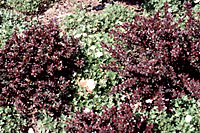 Q. We had a new brick walk leading to our front door installed in May and planted the spaces between the walk and
foundation with `Crimson Pygmy' barberry shrubs and perennials. Now there are all sorts of weeds coming up from the topsoil we used to fill
the space between the walk and foundation of our home. We've spent hours pulling weeds, but more keep popping up. What are
our options for dealing with these weeds?
Q. We had a new brick walk leading to our front door installed in May and planted the spaces between the walk and
foundation with `Crimson Pygmy' barberry shrubs and perennials. Now there are all sorts of weeds coming up from the topsoil we used to fill
the space between the walk and foundation of our home. We've spent hours pulling weeds, but more keep popping up. What are
our options for dealing with these weeds?
A. Once again the dilemma of weed-infested topsoil rears its ugly head. While getting up on my soapbox regarding the perils of "topsoil" won't help you at this point, I hope others reading this column will take heed.
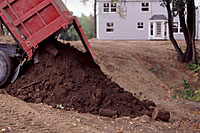 Plain and simple, it's very important to know where topsoil you bring on to your property comes from. You may even insist
that the supplier guarantee in writing that it's at least free of invasive, almost impossible to control weeds such as
field
and hedge bindweed, horsetail (at right, below), yellow nutsedge and Japanese bamboo. (Though I've never heard of any suppliers offering such
a guarantee,
Plain and simple, it's very important to know where topsoil you bring on to your property comes from. You may even insist
that the supplier guarantee in writing that it's at least free of invasive, almost impossible to control weeds such as
field
and hedge bindweed, horsetail (at right, below), yellow nutsedge and Japanese bamboo. (Though I've never heard of any suppliers offering such
a guarantee,
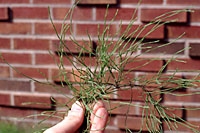 maybe it's about time given the large number of people that I've met over the years that have fought expensive,
ongoing battles against the weeds listed above.)
maybe it's about time given the large number of people that I've met over the years that have fought expensive,
ongoing battles against the weeds listed above.)
Alright, now that I've gotten that off my chest, let me offer what may be a relatively easy, though not instantaneous solution to your weed infestation - a diamond hoe!
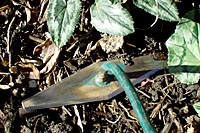 Finely honed on all four edges, the relatively small, diamond-shaped blade of this tool,
at left, can be pushed or drawn just at or
below the soil surface to cleanly slice through the stems, crowns and/or roots of herbaceous weeds and even the small, woody
stems of seedling trees. And, because the blade is set at the end of a slender five to six foot long handle, it can be used
while standing straight up, reducing the constant bending, stooping and crawling usually associated with weeding.
Finely honed on all four edges, the relatively small, diamond-shaped blade of this tool,
at left, can be pushed or drawn just at or
below the soil surface to cleanly slice through the stems, crowns and/or roots of herbaceous weeds and even the small, woody
stems of seedling trees. And, because the blade is set at the end of a slender five to six foot long handle, it can be used
while standing straight up, reducing the constant bending, stooping and crawling usually associated with weeding.
Once you've cut weeds off with this tool you can simply leave them on the soil surface to dry and decompose over the course of a week or two. And, because you can cover a lot of ground in a hurry with this tool, it's possible to move through your landscape beds every week or two to cut off any new growth that appears. By continually cutting off the leaves and stems of even the most well established weeds, you can eventually starve them to death, as they can't make new plant food (simple sugars) through the process of photosynthesis without leaves!
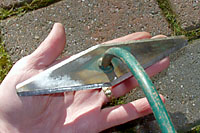 While farmers and
gardeners have used diamond hoes for well over a hundred years, you might not be able to walk into your
local garden center or hardware store and buy one. I found mine for about $35.00 at Lee Valley Tools (www.leevalley.com,
800-871-8158). Other suppliers/manufacturers include ProHoe, (web.inetba.com/prohoe/index.ivnu, 800-536-5450),
Corona Clipper (www.coronaclipper.com, 800-234-2547) and Gardener's Supply Company (www.gardener.com, 800-876-5520).
While farmers and
gardeners have used diamond hoes for well over a hundred years, you might not be able to walk into your
local garden center or hardware store and buy one. I found mine for about $35.00 at Lee Valley Tools (www.leevalley.com,
800-871-8158). Other suppliers/manufacturers include ProHoe, (web.inetba.com/prohoe/index.ivnu, 800-536-5450),
Corona Clipper (www.coronaclipper.com, 800-234-2547) and Gardener's Supply Company (www.gardener.com, 800-876-5520).